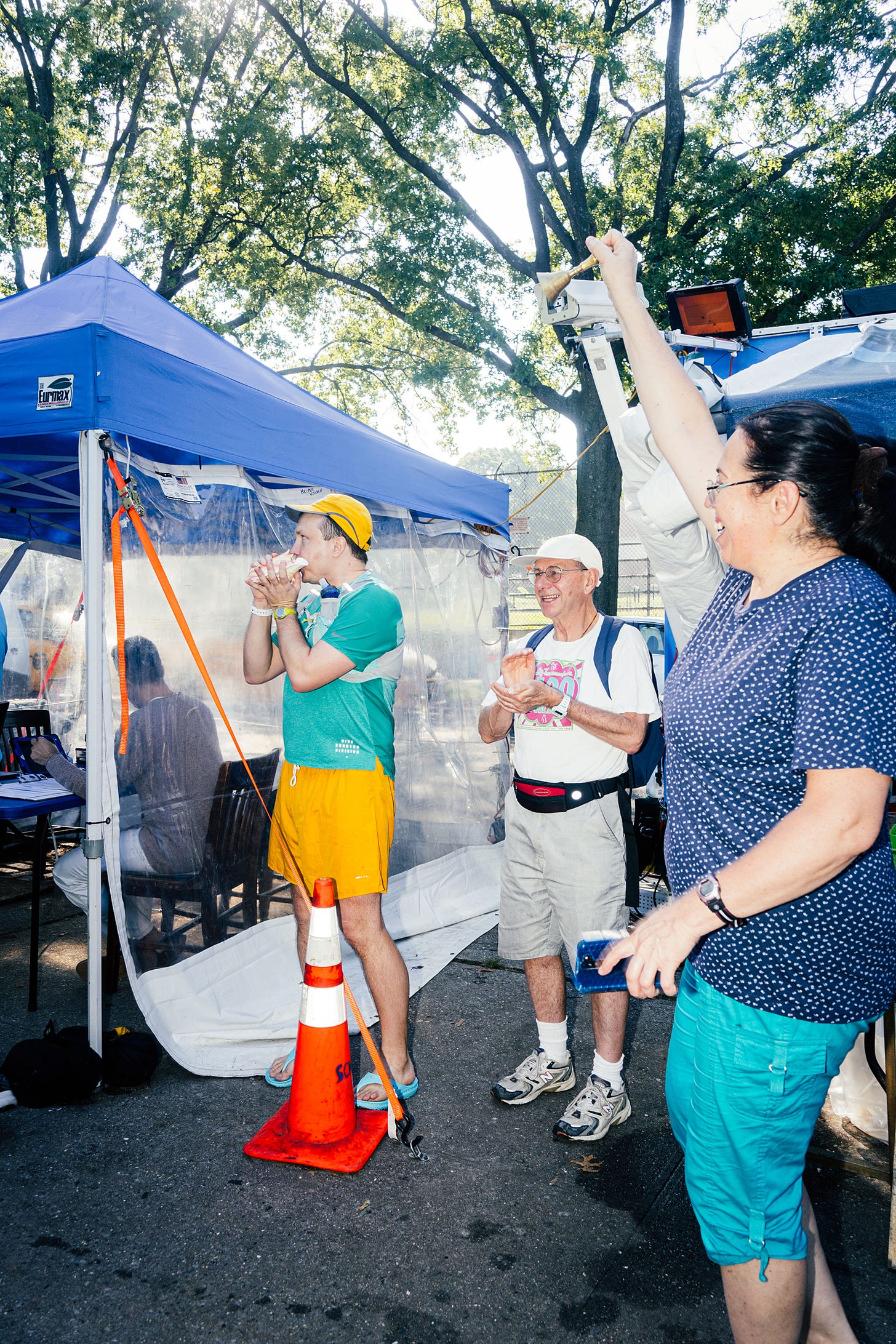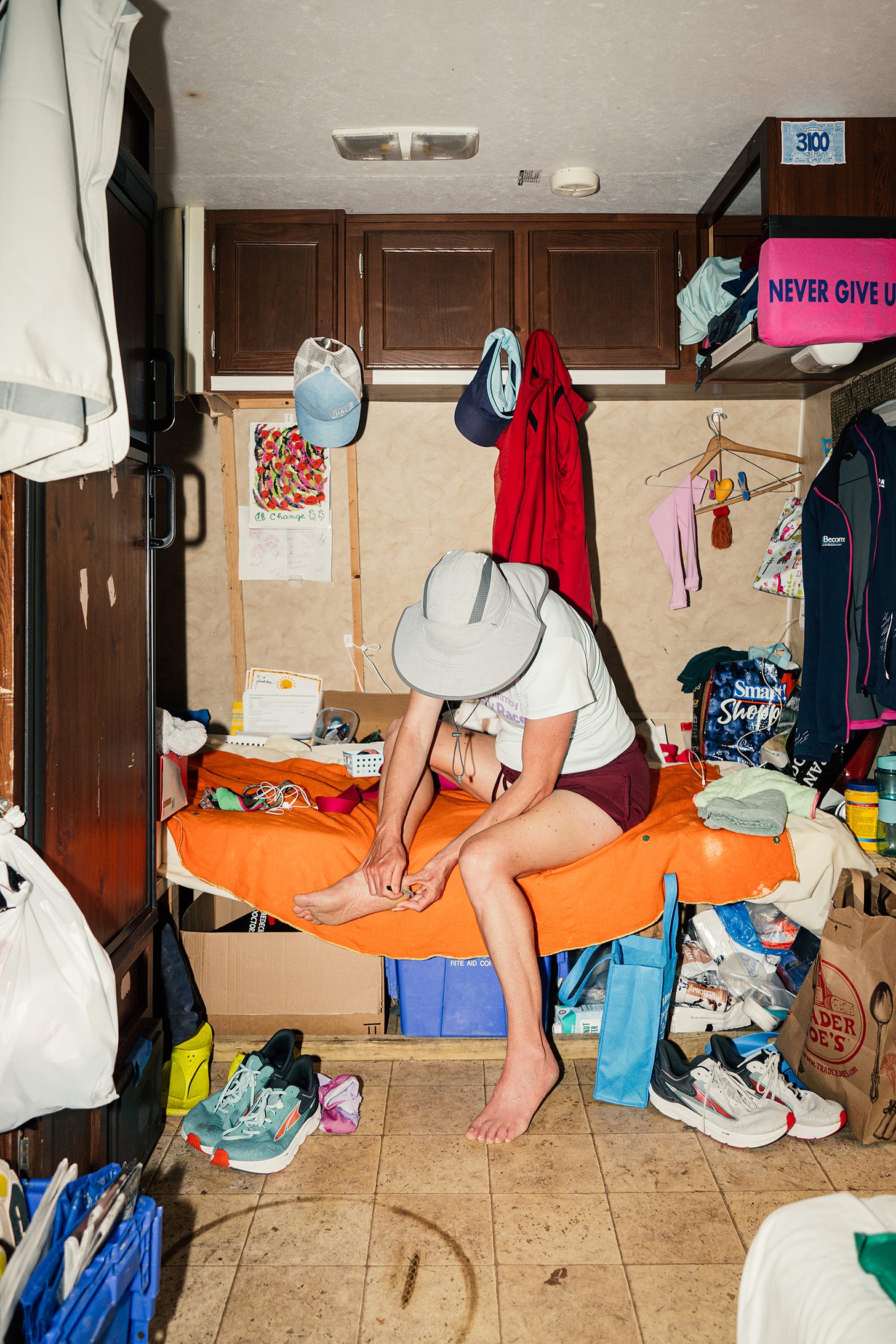Down 84th Avenue in Jamaica, Queens, around the four blocks that circle Thomas A. Edison Career and Technical Education High School, 14 people are running 3,100 miles in an attempt to do an even harder thing: transcend themselves.
“It’s a spiritual journey,” Jason Lester, the only American runner taking part, tells me during his 50th lap of the 33rd day of the 52-day race.
I’m wheezing, trying to keep up with him and Adrian Papuc, who came to Queens from Romania. I’m far too late in the game and far too out of shape—I ran high school cross-country, but was the slowest on the team and once lost a trail race to a girl on crutches—but I’m not past trying to achieve some measure of inner peace, especially these days. Even if it means getting up early on a Sunday to take the train, then a bus, to jog around a high school.
When I ask Lester why he thinks he’s the lone U.S. citizen he retorts, “I don’t see myself as an American. We’re all one.”
“The goal of this is to bring humanity together, and stop having these borders,” he explains. “There’s no way that we’re gonna be one in any of our issues that we have until we take those walls down.”
Lester, who has a tattoo on his arm that reads “Never give up,” is not a disciple of Sri Chinmoy, the Bengali guru and meditation teacher who settled in Queens and started this race 27 years ago, but most everyone else here is.
The Sri Chinmoy Self-Transcendence 3100 Mile Race is branded as the world’s longest certified footrace. Its distance honors the fact that Chinmoy was born in 1931. (Why they don’t just run 1,931 miles is painfully unclear.) The disciple-runners come from the Czech Republic, Poland, Romania, Slovakia, New Zealand, Ukraine, Russia, and Italy.
The rules of the race are simple. Runners must arrange for lodging within a half mile of the course, so that they can be picked up before 6 a.m. by race organizers and taken to the start line. The course is open from six to midnight for participants to run as far and as fast as they can in that time, for 52 days, with the hope that they will get to 3,100 miles. That means they have to average 59.6 miles per day. When I visit, only half of this year’s 14 runners are on track to get there.
Bipin Larkin, 67, one of the race directors, discovered Sri Chinmoy in 1972. He listened to the music of Carlos Santana and John McLaughlin, who were followers of Chinmoy; they were given the Sanskrit names Devadip and Mahavishnu, respectively. By 1975, Larkin was a disciple, which means he meditates twice weekly at one of the group’s centers, he’s a vegetarian, and he never married nor had kids.
“Sports is part of it,” says Larkin, who himself has run seventeen marathons and five longer ultra-marathons. “The guru believed that the physical body was like a temple for the soul. You practice your inner life and your outer life.” He calls the 3,100-mile race “an extreme dimension of it.” We’re interrupted by an older woman volunteer—“Wei-Ming is about to finish 2,100!”—and we grab bells from a Tupperware container to ring and scream when the Taiwanese man approaches. One of the women starts to laugh with delight.
The Chinmoy group has been accused of being a cult, and the guru—who died in 2007, though people here prefer to say he “left” or “departed this spiritual plane”—aroused suspicion with some of his own incredible physical feats, like lifting an airplane. But the vibe in Queens is more turkey trot on crack and less self-imposed ascetic torture.
The buff guys from a local Queens baseball league stare, stretching their backs with their bats as the cadre of middle-aged runners shuffles around the park, in the corner of the rectangular route, and past the field they play in. “You see them going all day, even when it’s pouring,” says Jessica Araujo, who is at the field to watch her boyfriend play baseball. “Some of them aren’t even wearing shoes.”
It’s true: Wei-Ming prefers sandals. The ones who do wear shoes are known to go through a pair every week or so. They prop their run-through shoes against a fence by the timekeepers’ tent, under a life-size shot of the guru.
The race is a show of sporting prowess that rivals the World Cup, the Olympics, and the Super Bowl. It takes running into the realm of performance art, and is a testament to the power of the mind over the body. It’s also completely nuts.
“You have energy points here, and also here,” Vajra Hinderson, 81, a Chinmoy disciple, tells me while digging his hands into the chest and shoulders of Vasu Duzhiy, 57, who came in fourth place last year has been averaging 61 miles per day for the past 33 days. We’re in the medical tent. Another volunteer is massaging coconut oil onto Vasu’s feet. Hinderson moves to the midsection. “You create a vortex of energy around this area here and it goes in and helps with the digestive system.”
On a table under two pictures of Sri Chinmoy—one of him running, another in which he’s staring straight ahead, eyes half-closed—sit a roll of kinesiology tape, scissors, a knife, a bottle of sesame oil, and a cabbage. Hinderson points to one of the portraits of the guru: “That’s my boss,” he says. “Even though he’s not in the physical body now, when I look at him and I’m thinking of him, that energy routes through me into him,” he continues, gesturing toward Vasu.
Another disciple, Garima Hoffman, 75, came in from San Francisco to man the food tent. “I move the cookies back when the kids get let out from school,” she tells me, swatting bees away from the Oreos, yogurt parfaits, bagels, and ginger carrot soup that she’s laid out.

It’s 10 a.m., and already the runners have gone through six sticks of butter, which are cut up into chunks on a plate for them to fork up. I’m told that calorie intake is one of the most important factors to keeping up an average of 60 miles per day. The 14 runners collectively consume between 40,000 and 60,000 per day. After my own four laps, the equivalent of two miles, I eat a cheese blintz, half of an everything bagel with cream cheese, a quarter of a sesame bagel with cream cheese, a Dixie cup of green tea, and a mozzarella stick to stay safe.
I caught up with Andrea Marcato, 41, for his 56th and 57th laps of the day. Marcato was born in Venice but works in Switzerland at a company that makes meat alternatives; he was a lifelong spiritual seeker and was “looking for ways to calm my mind” when he first visited a Sri Chinmoy center in Italy. This is the fourth time he’s run the 3,100 miles, and he’s in first place. (He’s since finished and won the race, with a time of 43 days,13 hours 33 minutes and 23 seconds.)
“It’s a very simple life. You eat, run, and sleep,” says Marcato. His life has been pared down to these four blocks, plus dealing with things like blisters, his nutrition, and rain. He doesn’t have time to read the news, but he asked a man who had come to run a few solidarity laps, a common occurrence especially when the weather is good, to give him the big picture. “He told me that the U.S. government almost shut down, and that the war in Ukraine is still going on and they’re sending more weapons.” (This was before war in the Middle East broke out, but after Trump was indicted in New York.) “He told me Trump is getting impeached or something.”
Gesiane Nascimento, 40, who came from São Paulo, Brazil, to help keep time for the runners, is hoping she can qualify for the race someday. To do that, she’ll have to clock 450 miles in a six-day race, which is also put on by the Sri Chinmoy Marathon Team. “We need to live in society, and live with the problems of the world and feel it,” she tells me as we hustle around the high school campus, cars whizzing past us on the Grand Central Parkway. “If each person feels oneness, we won’t need war. You’ll feel the other with your heart.”
Nascimento takes a break for a prasad, a food offering that’s been presented to a picture of the guru, and is thus consecrated by him, of Entenmann’s pumpkin donuts and cherry tomatoes. A tatted-up local guy called Mike Marin, a building superintendent, here with his long-haired spaniel named Mikey—“Don’t laugh, it’s true!”—says the race inspires him to push himself. “I do weights and a little cardio.”
He and Mikey come to watch every day. “I was like, what’s going on? It’s a spiritual and physical challenge. Some people are running in sandals. I think it’s great.”
“It’s all by the grace of Sri Chinmoy,” one of the runner’s helpers tells me as we watch Wei-Ming finish 2,100 miles.
Wen-Ya Tsai, 54, another runner from Taiwan (none of the three Taiwanese runners are disciples) is in second place. Her daughter and her son-in-law quit their jobs to come support her, and they’re camped out in folding chairs in front of a trailer with bottles of soybean milk and bouquets of flowers.
Wen-Ya and every other runner are going around and around the same block, which begs the question: after 3,100 miles, where does she hope to get? Szu-Han Lin, Wen-Ya’s daughter, shrugs. “She just tries to find a challenge, I think.”
Suzy Weiss is a reporter at The Free Press. Her last feature was about the short-lived loosening of the Senate dress code.
And if you appreciate our reporting, become a Free Press subscriber today:

















